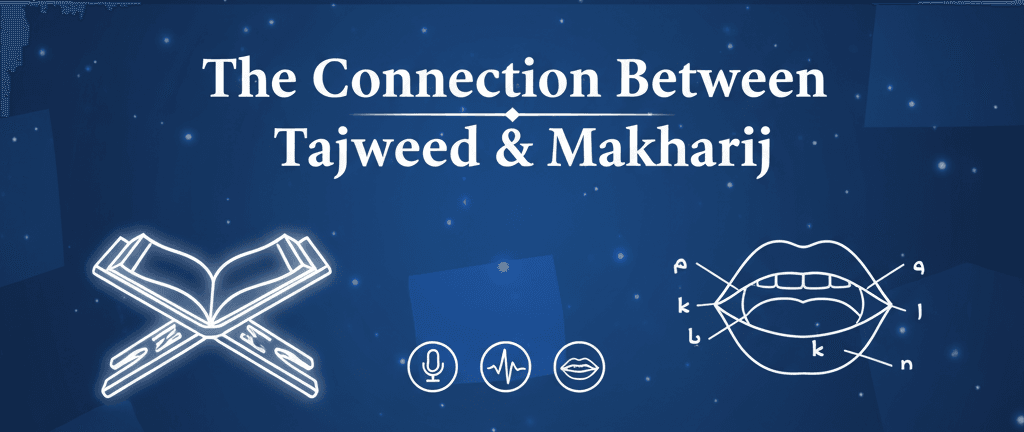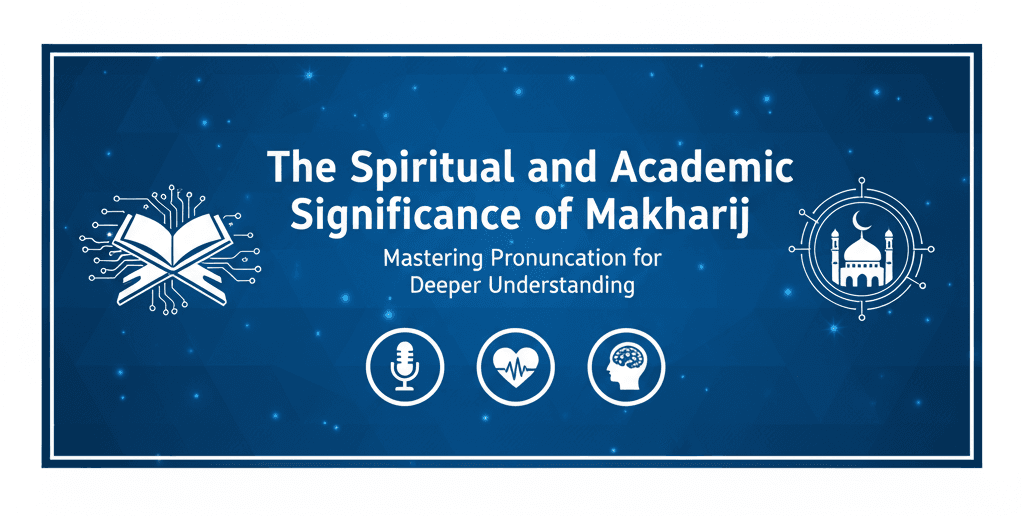Starting With The Name Of Almighty Allah
Reading the Quran with proper pronunciation is a deeply spiritual practice that enhances both the reciter’s connection to the divine text and the beauty of its recitation. The art of makharij al-huruf, or the articulation points of Arabic letters, is fundamental to reciting the Quran accurately. Mastering Quran makhraj rules ensures that each letter is pronounced correctly, preserving the meaning and sanctity of the divine words. This comprehensive guide will walk you through the essentials of makharij al-huruf basics, provide a makhraj pronunciation guide, and offer practical steps to read Quran makhraj correctly. Whether you’re a beginner or seeking to refine your skills, this blog will help you learn makharij letters and elevate your Quranic recitation.
The Quran, as the literal word of Allah, demands respect and precision in its recitation. The Prophet Muhammad (PBUH) emphasized the importance of proper recitation:
“The one who recites the Quran skillfully will be in the company of the noble and obedient angels, and he who recites the Quran with difficulty, stammering or stumbling through its verses, will have twice that reward.”
Sahih al-Bukhari, Book 65, Hadith 4937
This blog combines traditional Islamic teachings with practical advice to help you master makharij pronunciation Quran while acknowledging both the spiritual significance and the academic approach to learning tajweed makharij points.
Understanding Makharij Al-Huruf
Makharij al-huruf refers to the points of articulation from which Arabic letters originate in the mouth or throat. The term “makhraj” (singular) means the exit or point of origin of a letter, ensuring its distinct sound. There are 17 primary articulation points Quran letters, categorized into five main areas: the throat, tongue, lips, nasal cavity, and oral cavity. Mastering these makharij rules tajweed is essential for reciting the Quran as it was revealed.
From a traditional Islamic perspective, learning makharij al-huruf basics is not just a technical exercise but a spiritual obligation to honor the Quran’s divine nature. Historically, scholars like Imam Ibn al-Jazari emphasized the importance of tajweed and makharij to preserve the Quran’s authenticity. Academically, linguists view makharij as a sophisticated phonetic system that distinguishes Arabic from other languages, ensuring clarity and precision in pronunciation.
To understand how to use makhraj, you must first grasp the five main articulation areas:
- Throat (Al-Halq):
Letters like ‘ayn (ع), haa (ح), and hamza (ء) originate here.
- Tongue (Al-Lisan):
The tongue produces letters like taa (ت), daal (د), and qaf (ق), depending on its position.
- Lips (Ash-Shafatayn):
Letters like baa (ب) and meem (م) rely on lip movement.
- Nasal Cavity (Al-Khayshoom):
Used for ghunnah (nasalization) in letters like noon (ن) and meem (م).
- Oral Cavity (Al-Jawf):
Produces elongated sounds, such as the madd letters.
For a deeper dive into the definition and significance of makhraj, check out our blog on What Is Makhraj In Tajweed? Makharij Of Arabic Letters (Articulation).
Why Learning Makharij Matters for Quranic Recitation
Correct pronunciation through makharij ensures that the Quran’s meanings remain intact. A slight mispronunciation can alter a word’s meaning, potentially changing the intended message. For instance, the word qalb (heart) could be mispronounced as kalb (dog) if the qaf (ق) is not articulated correctly from its makhraj in the throat.
The Quran itself encourages beautiful recitation:
“And recite the Quran with measured recitation.”
Surah Al-Muzzammil (73:4)
From a traditional perspective, this verse underscores the importance of tajweed and makharij in recitation. Academically, makharij pronunciation Quran is studied as part of Arabic phonetics, emphasizing the language’s unique phonological structure. By enrolling in an Online Tajweed course, you can learn these principles systematically under expert guidance.
Step-by-Step Guide to Learn Makharij Letters
To learn makharij letters effectively, follow these practical steps, which combine traditional methods with modern learning techniques:
- Study the Articulation Points:
Begin with a makhraj pronunciation guide to understand where each letter originates. Use visual aids or charts to map out the 17 tajweed makharij points.
- Listen to Expert Reciters:
Listen to renowned reciters like Sheikh Mishary Rashid Alafasy or Sheikh Abdul Basit to hear the correct makharij pronunciation Quran. Mimic their pronunciation to internalize the sounds.
- Practice with a Teacher:
A qualified teacher can correct mistakes in real-time. Consider joining tajweed lessons online for personalized feedback.
- Use Repetition and Drills:
Practice each letter’s makhraj repeatedly. For example, focus on throat letters (haa, ‘ayn) until they sound distinct.
- Record and Review:
Record your recitation and compare it to expert recitations to identify errors in makharij al-huruf basics.
For additional tips on learning tajweed and makharij, explore our blog 10 Essential Tips To Learn Quran Fast With Tajweed.
Common Challenges in Mastering Makharij al-Huruf
Learning makharij can be challenging, especially for non-native Arabic speakers. Here are common obstacles and solutions:
| Challenge | Solution |
| Confusing similar-sounding letters (e.g., haa ح vs. haa ه) | Focus on their distinct makhraj (throat vs. chest) and practice with a teacher. |
| Difficulty with throat letters | Use slow, deliberate practice and listen to reciters emphasizing throat articulation. |
| Inconsistent pronunciation | Join a makharij workshop Quran or tajweed course online for structured learning. |
| Lack of feedback | Record your recitation and seek feedback from a qualified instructor. |
For more insights on overcoming tajweed challenges, read our blog Challenges in Learning Tajweed and Practical Ways to Overcome Them.
The Connection Between Tajweed & Makharij
Tajweed is the science of reciting the Quran with precision, and makharij is its foundation. While makharij focuses on the articulation of letters, tajweed encompasses rules for pronunciation, elongation, and rhythm. Understanding makharij rules tajweed ensures that you pronounce each letter correctly before applying other tajweed rules, such as madd (elongation) or idgham (merging).

For a comprehensive overview, visit our blog What is Tajweed in Quran? Tajweed Principles & Importance.
The Prophet Muhammad (PBUH) highlighted the beauty of proper recitation:
“Beautify the Quran with your voices, for a fine voice increases the Quran in beauty.”
(Sunan Abu Dawud, Book 8, Hadith 1468)
By mastering makharij al-huruf, you lay the groundwork for applying tajweed rules effectively. Enroll in Online Tajweed classes to deepen your understanding of both.
Practical Tips for Mastering Makharij Al-Huruf
To master makharij al-huruf, incorporate these tips into your learning routine:
- Start with Simple Letters:
Begin with letters like alif (ا) or baa (ب), which have clear articulation points.
- Use Visual Aids:
Charts and diagrams of articulation points Quran can help visualize where each letter originates.
- Practice Daily:
Dedicate 15–20 minutes daily to practicing makharij pronunciation Quran. Consistency is key.
- Join a Makharij Workshop:
A makharij workshop Quran provides hands-on guidance from experts. Alternatively, explore tajweed course options for structured learning.
- Learn from Mistakes:
Don’t be discouraged by errors. Use them as opportunities to refine your Quran makhraj rules.
For guidance on learning at home, check out How to Learn Quran with Tajweed at Home.
How Many Makhraj Are There in Tajweed?
There are 17 makharij in tajweed, grouped into five main areas, as mentioned earlier. Each makhraj corresponds to specific letters, ensuring their unique sounds. For a detailed breakdown, read our blog How many Makhraj are there in Tajweed?
The Spiritual and Academic Significance of Makharij
From a traditional Islamic perspective, mastering makharij is an act of worship that brings the reciter closer to Allah. The Quran’s divine nature requires that it be recited with utmost care, as emphasized in:

“Those to whom We have given the Book recite it with its true recital. They are the ones who believe in it.”
Surah Al-Baqarah (2:121)
Academically, makharij is a subject of linguistic study, showcasing the complexity of Arabic phonetics. Scholars analyze how makharij preserves the Quran’s oral tradition, ensuring its transmission across generations without distortion. By combining both perspectives, learners can appreciate the spiritual and intellectual depth of makharij pronunciation Quran.
How Long Does It Take to Learn Makharij?
The time required to master makharij varies based on your background, dedication, and learning method. Beginners may take 3–6 months to grasp the basics, while advanced learners can refine their skills in 1–2 years with consistent practice. For a detailed guide, read “How Long Does It Take to Learn Tajweed?”.
Integrating Makharij into Your Daily Quran Recitation
To read Quran makhraj correctly in daily practice:
- Warm Up Your Voice:
Practice throat and tongue exercises to prepare for recitation.
- Focus on One Makhraj at a Time:
Master one articulation point before moving to the next.
- Recite with Intention:
Approach recitation with sincerity, as it enhances focus and pronunciation.
- Use Technology:
Apps and online resources can reinforce makharij al-huruf basics. Consider joining programs to learn Quran with Tajweed for guided learning.
For a difference between the two, tajweed and makharij, explore What is tajweed and makhraj? Difference Between Makhraj and Tajweed.
Learning Makharij and Tajweed From A Reputable Institution
At Najam Academy, we are committed to helping you master Quran makhraj rules and tajweed through expert-led, affordable online courses. As a leading online Quran academy in the USA and UK, with a global reach, we offer personalized tajweed and makharij lessons tailored to your pace and level. Our experienced instructors guide you through makharij pronunciation Quran with practical feedback, ensuring you recite the Quran with confidence and precision. Join thousands of students worldwide who have transformed their recitation with our Online Tajweed course and start your journey to mastering makharij al-huruf today.
Key Citations:
- Sahih al-Bukhari, Book 65, Hadith 4937
- Sunan Abu Dawud, Book 8, Hadith 1468
- The Holy Quran, Surah Al-Muzzammil (73:4)
- The Holy Quran, Surah Al-Baqarah (2:121)




